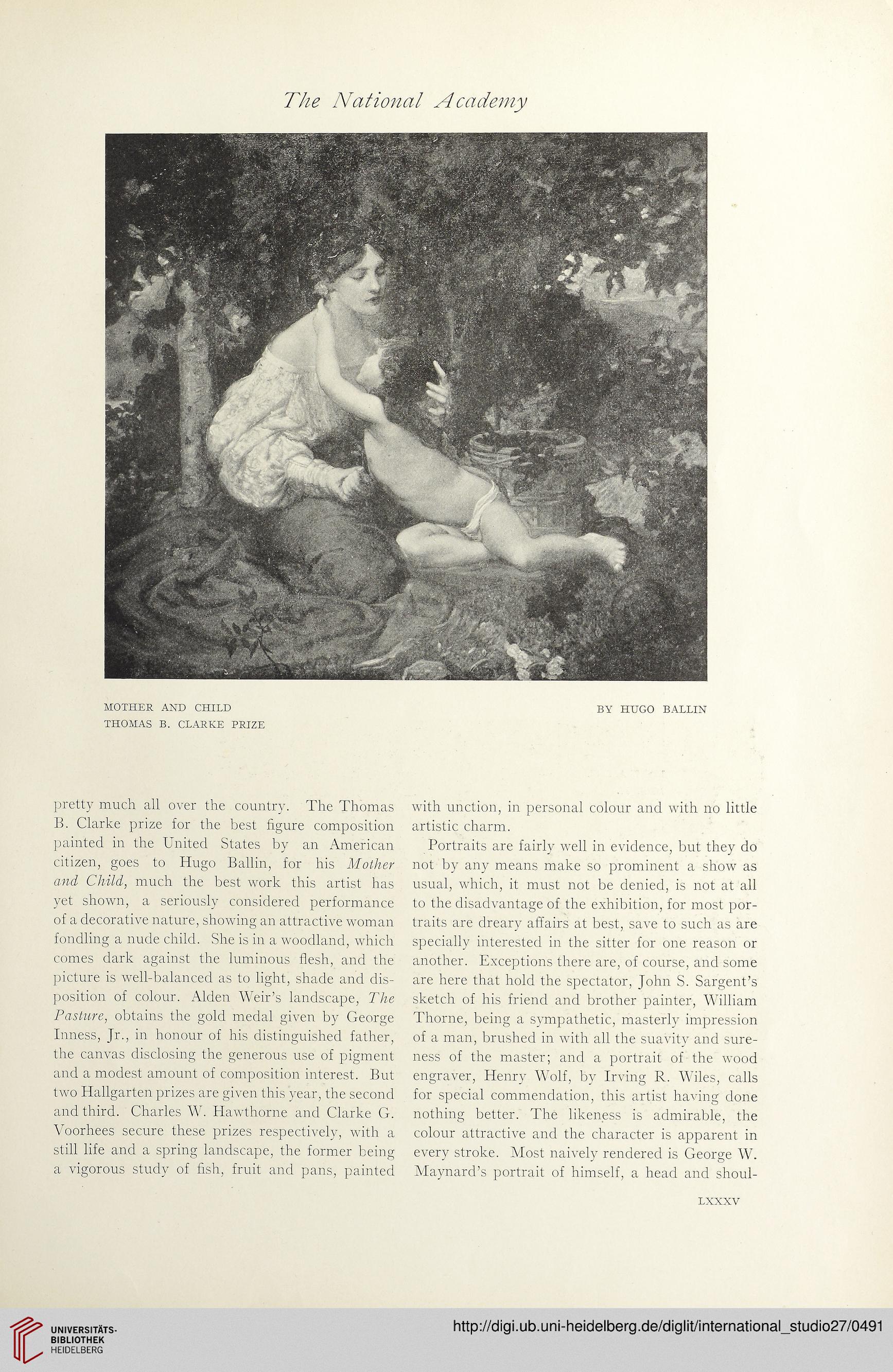The National Academy
MOTHER AND CHILD BY HUGO BALLIN
THOMAS B. CLARKE PRIZE
pretty much all over the country. The Thomas
B. Clarke prize for the best figure composition
painted in the United States by an American
Citizen, goes to Hugo Ballin, for his Mother
and Child, much the best work this artist has
yet shown, a seriously consiclered performance
of a decorative nature, showing an attractive woman
fondling a nude child. She is in a woodland, whicli
comes dark against the luminous flesh, and the
picture is well-balanced as to light, shade and dis-
position of colour. Alden Weir’s landscape, The
Pasture, obtains the gold medal given by George
Inness, Jr., in honour of his distinguished father,
the canvas disclosing the generous use of pigment
and a modest amount of composition interest. But
two Hallgarten prizes are given this ’year, the second
and third. Charles W. Hawthorne and Clarke G.
Voorhees secure these prizes respectively, with a
still life and a spring landscape, the former being
a vigorous study of fish, fruit and pans, painted
with unction, in personal colour and with no little
artistic charm.
Portraits are fairly well in evidence, but they do
not by any means make so prominent a show as
usual, which, it must not be denied, is not at all
to the disadvantage of the exhibition, for most por-
traits are dreary affairs at best, save to such as are
specially interested in the sitter for one reason or
another. Exceptions there are, of course, and some
are here that hold the spectator, John S. Sargent’s
sketch of his friend and brother painter, William
Thorne, being a svmpathetic, masterly impression
of a man, brushed in with all the suavity and sure-
ness of the master; and a portrait of the wood
engraver, Henry Wolf, by Irving R. Wiles, calls
for special commendation, this artist having done
nothing better. The likeness is admirable, the
colour attractive and the character is apparent in
every stroke. Most naively rendered is George W.
Maynard’s portrait of himself, a head and shoul-
LXXXV
MOTHER AND CHILD BY HUGO BALLIN
THOMAS B. CLARKE PRIZE
pretty much all over the country. The Thomas
B. Clarke prize for the best figure composition
painted in the United States by an American
Citizen, goes to Hugo Ballin, for his Mother
and Child, much the best work this artist has
yet shown, a seriously consiclered performance
of a decorative nature, showing an attractive woman
fondling a nude child. She is in a woodland, whicli
comes dark against the luminous flesh, and the
picture is well-balanced as to light, shade and dis-
position of colour. Alden Weir’s landscape, The
Pasture, obtains the gold medal given by George
Inness, Jr., in honour of his distinguished father,
the canvas disclosing the generous use of pigment
and a modest amount of composition interest. But
two Hallgarten prizes are given this ’year, the second
and third. Charles W. Hawthorne and Clarke G.
Voorhees secure these prizes respectively, with a
still life and a spring landscape, the former being
a vigorous study of fish, fruit and pans, painted
with unction, in personal colour and with no little
artistic charm.
Portraits are fairly well in evidence, but they do
not by any means make so prominent a show as
usual, which, it must not be denied, is not at all
to the disadvantage of the exhibition, for most por-
traits are dreary affairs at best, save to such as are
specially interested in the sitter for one reason or
another. Exceptions there are, of course, and some
are here that hold the spectator, John S. Sargent’s
sketch of his friend and brother painter, William
Thorne, being a svmpathetic, masterly impression
of a man, brushed in with all the suavity and sure-
ness of the master; and a portrait of the wood
engraver, Henry Wolf, by Irving R. Wiles, calls
for special commendation, this artist having done
nothing better. The likeness is admirable, the
colour attractive and the character is apparent in
every stroke. Most naively rendered is George W.
Maynard’s portrait of himself, a head and shoul-
LXXXV





